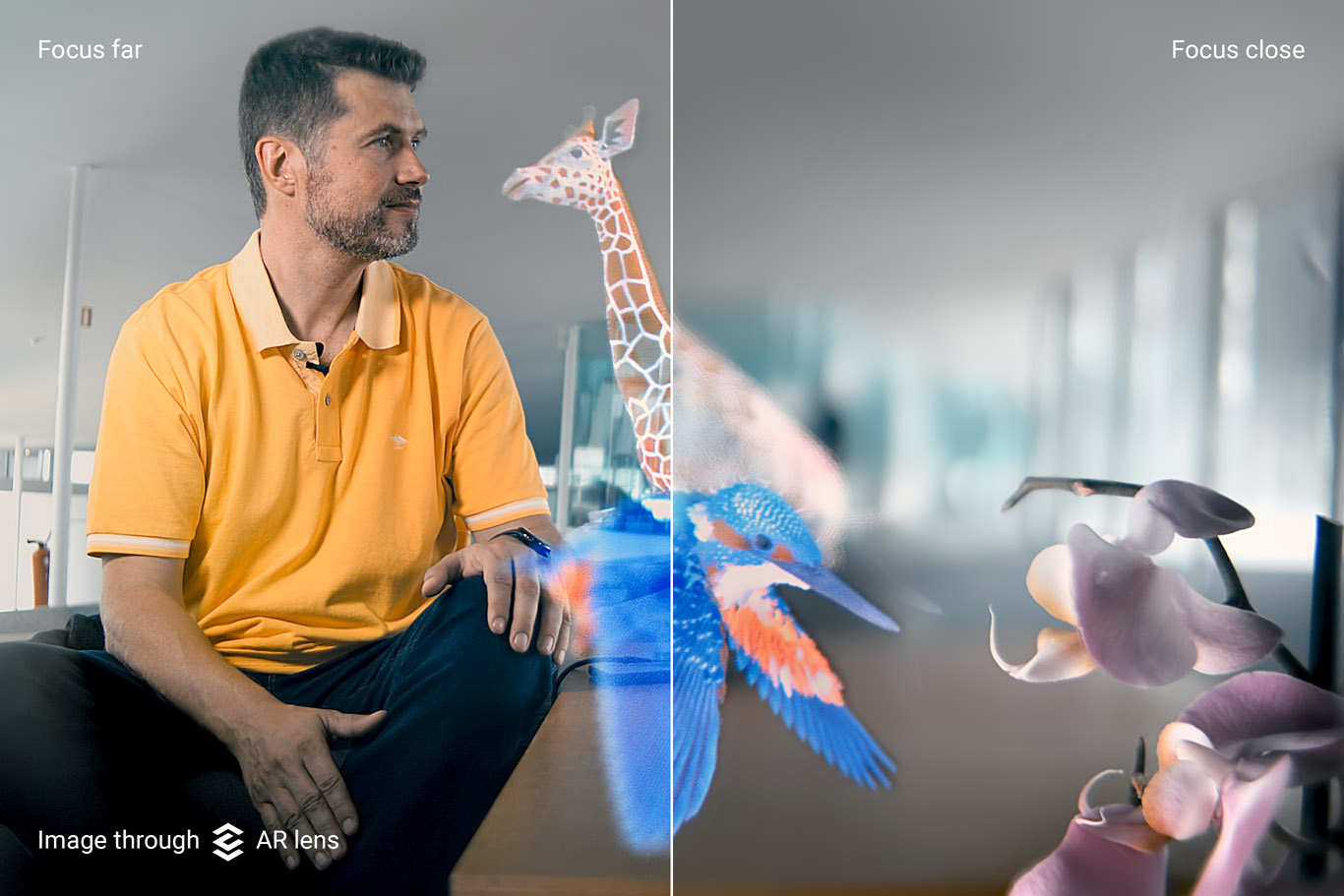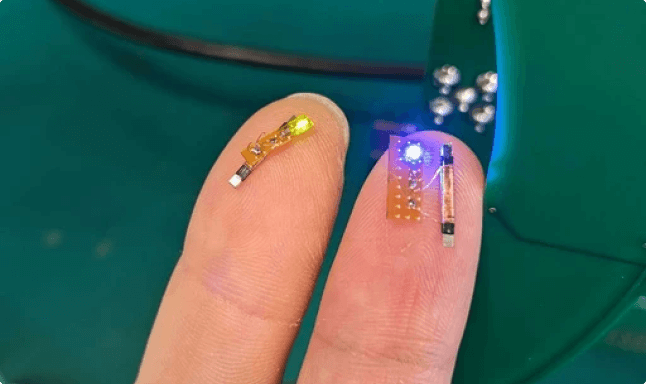CREAL Lightfield display will be available in 2024 to make AR more realistic
There’s been a very interesting piece of news that the last week went below the radars of many XR magazines but that I think it’s worth talking about: CREAL has announced the commercial availability of its lightfield solution for XR glasses for 2024. Why is it cool and why should we matter?
CREAL’s Light Field “display”
CREAL is one of the most interesting startups for what concerns XR display solutions. It is not the manufacturer of a new OLED screen, but a company trying to ditch the concept of XR as “a screen on your face” in favor of the one of Light Fields. Long story short, with light fields, there is not a screen, but a visual system that tries to replicate in front of your eyes the light rays that they would receive if the virtual scene you had in front of you was real.

So, if you see a little bird in AR:
- With the traditional solutions, you have two screens, one per eye, that show on their pixels the image of the whole bird as seen from both eyes. This is not how real vision works, because this solution forces your eyes to focus on the screen, and not on where the bird is expected to be
- With light fields, the “emitter” tries to cast around your eyes the same light rays (with the same color and orientation) that your eyes would receive if the bird was really in the position that it is seen at. Since the system tries to emulate how real light works, your eyes can work with it in the same way they do when they see real objects, meaning that they can truly focus on the virtual bird.

The fact that the eyes can work “naturally” with light-field displays, means that with light fields, many typical problems of XR are solved. Since your eyes can focus on the objects:
- you can focus on virtual elements that are very close to your eyes
- your eyes focus at the right distance for every object, and they don’t focus at the fixed distance of the display, so no more vergence-accommodation issue is present
- This reduces nausea, eye strain, and eye fatigue while using XR
- you can focus on some virtual objects and see the other virtual objects at different distances blur out, like in real life
- in AR you can focus on a virtual and a real object that are at the same distance together, making the fusion of real and virtual elements more realistic.
Light fields are a big deal and can improve a lot the sense of immersion in AR/MR experiences.
Hands-on

CREAL is a very serious and talented company. I visited their HQ a few years ago and tried all their prototypes for having light fields both for AR and VR and came out pretty impressed by them. You can read my long article that talks about that experience by clicking on this link.
There are a few things that were great with their prototypes:
- Lightfields let you focus for real at different distances. I could focus on holograms very close to me or very distant ones. Everything was as they claimed it to be
- Lightfields made me perceive virtual objects as “more 3D”. I use this term to explain how the depth of a virtual object seen through lightfields is nuanced, it appears more as having depth, and seems more realistic than another one seen through a traditional XR device. 3D elements truly stand out.

It’s crazy that the vision offered through light fields is so natural that during my hands-on my eyes didn’t find it special at all… for them, it was like seeing real objects! My first reaction was “OK, what’s special here?” and then I realized that its specialty was indeed being so natural to use that focusing on objects didn’t feel like I was using AR glasses.
Of course, we are talking about a new technology, so during my tests I also noticed some drawbacks: the FOV was quite limited, and the 3D holograms were a bit transparent all looked like made of very noisy little colored dots. Not to mention that all the components were still quite bulky. When I tried it the first time, there was still a lot of work to do.
CREAL at AWE 2023

When in June I went to AWE 2023 in Santa Clara, I was able to meet the CREAL guys and see what were their latest updates (and yes, we also had fun together, but that’s another part of the story for another day :P).
First of all, I tried again their AR glasses prototype and noticed that the quality of the holograms looked improved. They seemed less noisy than my first experience with them. The noise was still there, though, and was especially noticeable with objects close to my eyes. Anyway, it was nice to see a quality improvement.
The star of the show was anyway the new miniaturization of the light field engine, to make it closer to commercial availability. They showed me the plastic frame you can see in the picture below, saying that the system could fit there, but it could potentially be miniaturized even more.

If you have followed CREAL since it got popular at CES a few years ago, for sure you find it remarkable that what was a huge box now fits very thick glasses frames. Of course, some compromises have been made in the process (I’ve been told the big box offered the best experience possible), but now the system is usable and can fit some prototypical AR glasses.
The ray engine has to be paired with glass lenses, that should be covered with a very thin holographic film to allow for the holographic magic to happen when working with the rest of the system.

The holographic film doesn’t impact much the transparency of the lens: when I met the company, they told me that the transparency factor was 92%, but could be evolved up to 97%. This is great because it means that the CREAL AR system doesn’t hurt the visibility of what you have around you. But the most remarkable feature of this thin holographic film is that it can be applied to every lens, so you can also add it to your prescription lenses, and have light-field AR glasses that work well with your eyes!

If you look at the system showcased at AWE, you see that it is made of some small parts and some huge black boxes. I was pretty confused by the company talking about miniaturization when there were these big boxes on the table, so I asked Tomas Sluka, the CEO of the company, to explain to me what was happening. He told me that the big parts are the parts that are not related to the lightfield engine and that are the standard electronics that are present in XR glasses that allow the engine to work… companies with hardware expertise (e.g. Goertek) already know how to miniaturize this, so it was not interesting to show it in the prototype. CREAL does not want to build its glasses, but it is looking for partners willing to build their glasses by integrating its solution. And this leads us to the news of the day.
CREAL announces the commercial availability of its solution

On September, 26th, CREAL announced “the commercial availability by early 2024 of its patent-protected AR display technology stack, which enables OEM/ODMs to develop AR glasses that uniquely provide correct depth perception to users”. Long story short: next year, the first manufacturers could start producing AR glasses using CREAL lightfield technology. And it seems that some of them are already considering this possibility: in the press release announcing the news, the company states that “several leading AR glasses and headset ODM’s are currently evaluating CREAL technology for their next-generation designs, expected to become commercially available in 2024″.
The specs of the current solution are the ones listed in this slide:

As you can see, the FOV is the Achille’s heel of the CREAL “display”, but most current AR glasses have a narrow FOV anyway, so maybe some companies may already think about experimenting with creating AR glasses with this technology.
Honestly given the novelty of the technology and the long-term vision AR has, I don’t expect a flock of companies to implement this system today, but I can imagine many of the major players experimenting internally with it evaluating a launch of a CREAL-based product for the upcoming years. Having tried the added sensation of realism and natural mixing between real and virtual elements, I am sure that light-field is going to be the technology that XR will employ in the future. And I can’t wait to see commercial AR glasses implement it.
CREAL has announced that it has raised $18M to date, and aims at starting a new funding round now to carry on the development of its technology (which needed 6 years to arrive at this point). I hope they can get the money because I’m curious to see how the evolution of this system can be. My eyes are ready 🙂
(Header image by CREAL)
Disclaimer: this blog contains advertisement and affiliate links to sustain itself. If you click on an affiliate link, I'll be very happy because I'll earn a small commission on your purchase. You can find my boring full disclosure here.



